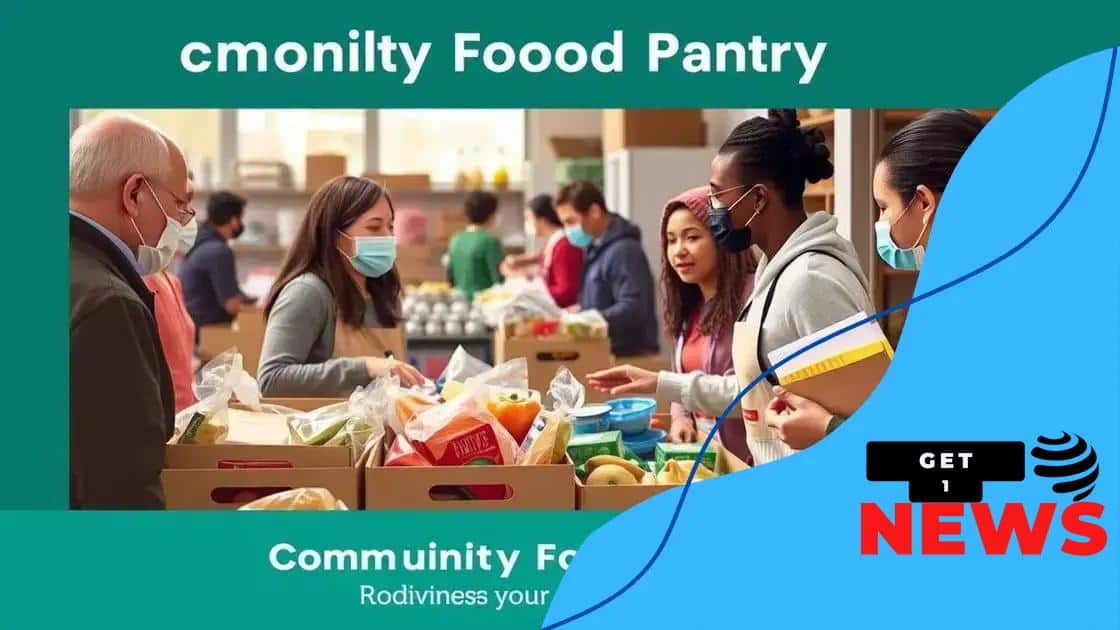Food assistance program improvements: what you need to know

Food assistance program improvements focus on personalized support, community engagement, technology integration, and sustainability to effectively address food insecurity and meet diverse needs in communities.
Food assistance program improvements could reshape how resources reach those in need. Have you ever wondered how these programs adapt to better serve communities? In this article, we dive into the latest advancements and their significance.
Understanding the current food assistance programs
Understanding the current food assistance programs is essential for recognizing their impact on communities. These programs aim to provide vital resources to individuals and families facing food insecurity. With a focus on support and outreach, many initiatives work to address nutritional needs across various demographics.
Types of Food Assistance Programs
There are several types of food assistance programs available today. Here are some key ones:
- Supplemental Nutrition Assistance Program (SNAP): This program provides low-income individuals with funds to purchase food.
- Women, Infants, and Children (WIC): WIC offers nutritional support to pregnant women and children under five.
- Food Distribution Programs: These initiatives supply food directly to community food banks and pantries.
- School Meal Programs: Many schools provide free or reduced-price meals to ensure children have access to nutritious food.
Each program has unique requirements and benefits. Understanding these can help eligible individuals access the resources they need. For example, SNAP benefits vary based on household size and income, making it crucial for applicants to comprehend the application process.
Challenges Facing Food Assistance Programs
Despite their importance, food assistance programs face numerous challenges. For instance, funding can be inconsistent, impacting the availability of resources. Additionally, outreach efforts may fall short, leaving many unaware of the assistance available. This can lead to missed opportunities and increased food insecurity.
Moreover, as the landscape of food needs changes, programs must adapt to serve a diverse population effectively. This means tailoring approaches for different communities, ensuring inclusivity and accessibility.
Future of Food Assistance Programs
The future of food assistance programs looks promising as advancements in technology and policy changes pave the way for improvements. Innovative strategies, such as mobile applications for food distribution, are emerging to enhance access. Additionally, collaborations with local businesses can provide more resources and support.
Overall, understanding the current food assistance programs is critical for promoting awareness and improving the support systems in place. By fostering knowledge and outreach, these initiatives can continue to make a significant difference in the lives of those they serve.
Key improvements in food assistance framework
Key improvements in food assistance framework can significantly upgrade the way these vital resources are distributed. With changing needs and technology, adapting these programs is essential. Enhanced efficiency, accessibility, and responsiveness can lead to better outcomes for those in need.
Streamlining Application Processes
One notable improvement is the simplification of application procedures for programs like SNAP. By making the application more user-friendly, more people can access assistance. This might include online applications and fewer required documents, making it easier for families to get help.
- Online access to applications and resources helps many.
- Reducing documentation requirements decreases application barriers.
- Simplified eligibility criteria encourages participation.
These changes often lead to increased enrollment rates, making a substantial difference in communities. As information becomes readily available, the unseen barriers to applying for aid are gradually removed.
Incorporating Technology
The use of technology also plays a crucial role in improving food assistance programs. With mobile applications and digital platforms, individuals can find resources easily. For instance, data analytics helps identify areas with high food insecurity, guiding targeted support where it’s most needed.
Moreover, technology enables better communication between agencies and beneficiaries. Regular updates and notifications can keep families informed about their benefits and important deadlines.
Collaboration with Local Organizations
Enhancing partnerships with local organizations has proven effective in improving food assistance frameworks. By working with food banks, schools, and community groups, programs can tailor their offerings to meet specific community needs. Such collaboration may include:
- Coordinated food drives for targeted assistance.
- Community events to raise awareness about available resources.
- Feedback loops with beneficiaries to refine services.
These partnerships ensure that assistance is not only available but also relevant and effective. By fostering a community-centered approach, food assistance programs can better serve those they aim to support.
As food assistance programs evolve, embracing these key improvements will enhance their effectiveness. Adapting to the needs of recipients and using innovative tools will ensure these programs remain vital lifelines for many.
Impact of technology on food assistance

The impact of technology on food assistance has been transformative, opening new avenues for efficiency and access. From digital applications to advanced data tracking, technology enhances the way assistance reaches those in need.
Digital Platforms for Access
One major advancement is the use of digital platforms that streamline access to food assistance programs. With apps and websites, individuals can easily find information about eligibility and apply for services such as SNAP. This ease of access encourages more people to seek help.
- Online applications reduce waiting times significantly.
- Mobile alert systems provide updates about benefits and deadlines.
- Accessibility features assist those with disabilities in applying.
By using technology, applications become user-friendly, ensuring participants can navigate the process with minimal barriers.
Data Analytics for Targeted Support
Technology also plays a critical role in data analytics, allowing organizations to identify areas with the highest need for food assistance. Through data collection, agencies can analyze food insecurity patterns and tailor their programs accordingly. This targeted approach helps allocate resources more effectively, ensuring that support reaches the right communities.
Moreover, leveraging data allows for better planning and forecasting, ensuring steady supplies and support at the local level. Programs can quickly adapt based on changing needs, enhancing overall responsiveness to food insecurity.
Collaborative Efforts Through Technology
Tech-enabled collaborations among organizations are increasing as well. Partnerships formed through shared platforms can improve outreach and service delivery. For example, food banks collaborating with local schools to ensure students receive meals during weekends can utilize technology to coordinate efforts efficiently.
- Shared platforms help track food donations and needs.
- Collaborative scheduling maximizes food distribution.
- Community engagement through social media amplifies partners’ messages.
These collaborative efforts create a more integrated approach to food assistance, where technology tracks progress and facilitates connections.
In conclusion, the impact of technology on food assistance is profound. By simplifying access, enhancing data-driven strategies, and fostering collaborations, technology continues to play a pivotal role in addressing food insecurity.
Case studies of successful program enhancements
Case studies of successful program enhancements reveal how innovative strategies can drastically improve food assistance outcomes. These examples demonstrate how thoughtful adjustments can lead to greater efficiency and accessibility.
Example 1: The Hunger Program
One notable case is the Hunger Program in Urban City. By integrating community feedback into its design, the program adapted its food distribution methods. They introduced mobile food pantries that served specific neighborhoods based on need. This adjustment increased participation by 30%, allowing thousands more residents to access nutritious meals.
Example 2: Collaborative Nutrition Initiatives
Another example involves a local collaborative nutrition initiative in Smalltown. This program partnered with schools to provide after-school meals. By collaborating with local farmers, they sourced fresh produce for children. As a result, the initiative not only enhanced the variety of food available but also educated children about nutrition. The program saw healthier eating habits among participants, reflected in surveys.
Example 3: Technology and Outreach
A third impactful case is a tech-based outreach initiative by a nonprofit named FeedForward. They developed an app that helps users locate nearby food resources. The app includes features like ingredient matching and meal suggestions based on available resources. Within a year of its launch, user engagement grew by 50%, allowing more families to benefit from existing programs.
Key Takeaways
These case studies highlight several important elements that contribute to successful program enhancements. They include:
- Incorporating community feedback into program design.
- Leveraging partnerships with local organizations for resource sharing.
- Utilizing technology to increase access and efficiency.
By looking at these examples, other programs can adopt similar strategies. Through focused enhancements, food assistance programs can effectively meet the evolving needs of their communities.
Future trends in food assistance initiatives
Future trends in food assistance initiatives are shaping the way communities address food insecurity. As challenges evolve, these programs are adapting to meet the needs of diverse populations more effectively.
Personalized Assistance Programs
One significant trend is the movement towards personalized assistance. Programs are increasingly using data analytics to tailor support based on individual needs. This could include offering specific nutritional guidance and connecting families with local resources for healthy food options. By focusing on personal needs, food assistance can have a more profound impact on health outcomes.
Community-Based Approaches
Another emerging trend is the emphasis on community-based approaches. Local organizations are collaborating more frequently to create networks of support. This strategy not only addresses food availability but also enhances community engagement. For instance, local farms and food banks may work together to provide fresh produce directly to neighborhoods with limited access to grocery stores.
- Building partnerships with local growers ensures fresh food supply.
- Engagement events raise awareness about available services.
- Shared resources can lower operational costs for assistance programs.
These partnerships can create a stronger safety net for those in need.
Technology Integration
Technology continues to play a crucial role in shaping future food assistance initiatives. With advancements like mobile applications, beneficiaries can easily locate resources and receive real-time updates about available services. Apps that connect users with local food distributions and nutritional resources are becoming more common.
Furthermore, online platforms facilitate education on meal preparation and healthy eating habits. Virtual workshops can engage individuals, fostering knowledge that empowers families to make healthier choices.
Sustainable Practices
Lastly, there is a growing focus on sustainability within food assistance programs. Initiatives are increasingly considering the environmental impact of food distribution. This includes prioritizing local food sources to reduce carbon footprints and implementing practices to minimize food waste.
- Utilizing composting and recycling in food programs.
- Encouraging local sourcing of food products to strengthen local economies.
- Innovating methods for preserving food to extend its shelf life.
These sustainable practices not only help the environment but also support community resilience.
FAQ – Frequently Asked Questions About Food Assistance Initiatives
What are the main trends in food assistance initiatives?
The main trends include personalized support, community engagement, technology integration, and sustainable practices.
How is technology improving access to food assistance?
Technology helps by providing apps that connect users with resources, allowing for easier navigation and real-time updates.
Why is community engagement important in food assistance programs?
Community engagement fosters collaboration, ensuring that support networks are stronger and can better meet the needs of individuals.
What does personalized support mean in food assistance?
Personalized support tailors assistance based on individual needs, allowing programs to effectively address specific dietary requirements and food preferences.





